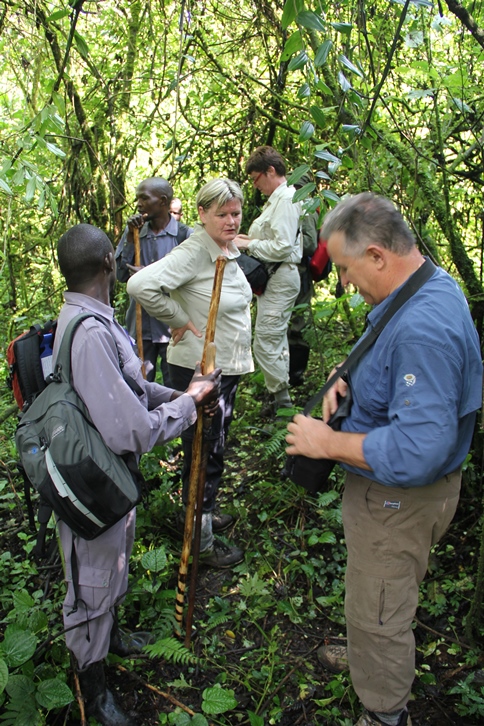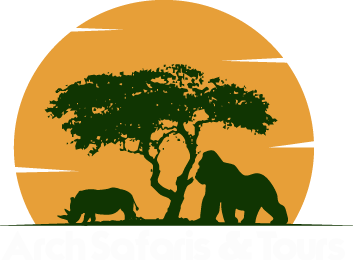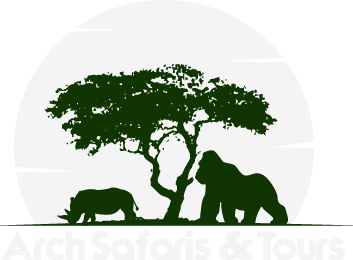Rushaga gorilla trekking Area in Bwindi Impenetrable national park lies in the southern sectors of this park. This is one of the four gorilla trekking areas that Uganda Wildlife Authority considered when subdividing vast Bwindi impenetrable National park into areas. The huge area of this national park, which is about 327 square kilometers of dense forest cover, made administration quite challenging to manage all activities in the forest including gorilla trekking or gorilla habituation.
Other gorilla trekking areas in Bwindi Include Buhoma area the main administrative area for Bwindi Forest, Nkuingo area and Ruhija area.
At the moment Rushaga gorilla trekking area has the largest number of habituated gorilla families open for tourism . These include Nshongi gorilla family, Mishaya gorilla family, Bweza gorilla family, Busingye gorilla family, Kahungye gorilla family, Bikingi gorilla family, Mucunguzi gorilla family, and Rwigi gorilla family.
To be allowed to do gorilla trekking in Rushaga area, you must obtain a gorilla permits from Uganda Wildlife authority or a licensed tour operator like Arch Safaris And Tours
Two gorilla families in Rushaga area are open for gorilla habituation. Gorilla habituation is the process of getting wild mountain gorillas used to the presence of human beings. This takes some years from about 2 years or more depending on how the mountain gorillas cope
The Rugged Rushaga area is beautifully places in an eye captivating area overlooking the Virunga volcanoes, can see Lake Bunyonyi the deepest lake in Uganda, clearer view of the green surrounding and others.
What Are the Gorilla Families in Rushaga Area
Note that the gorilla trekking families in Bwindi Impenetrable national park members keep changing in number as more birth, splits and deaths occur. The number below are recorded according to what is in Rushaga area at the moment.

Nshongi Gorilla Trekking Family
Nshongi gorill family which is so far the largest ever habituated gorilla family in Bwindi Impenetrable National park is one of the original members of the Rushaga area. The family derives its name from River Nshongi were it was first spotted. By the time habituating Nshongi family, it had about 34 members.
Its glory did not last long as quest for dominancy and authority became an issue especially amongst the silverbacks in the family causing regular fights and rangels.
These unending fights in the family led to the breakaway of Mishaya family in 2010 later Bweza gorilla family in 2012.
At the moment, Nshongi gorilla family has about 8 members of which there is 1 silverback, 1 black back, I juvenile, 3 adult females and 2 infant
Busingye Gorilla Trekking Family
Busingye gorilla trekking family split from Kahungye family in 2012 under the leadership of Dominant silverback Busingye. Locally the name Busingye means peace but this is the opposite of this dominant silverback because he loves wedging wars on others to expand his family.
At the moment, Busingye gorilla group is composed of 12 family members including I silverback, 5 adult females, 1 blackback, 2 infants and 3 Juveniles.
This gorilla group is charming to watch because of the unsettling nature of the youngsters in the family. You may never get bored watch them go about there day today activities.
Mishaya Gorilla Trekking Family
Mishaya gorilla family was first habituated in 2010 after splitting from Nshongi gorilla family. This was under the leadership of Mishaya who suddenly met his death in 2014. His death left the gorilla family in despaired because of lack of leadership and majority of the members found there way out. Some of the family members joined Bweza gorilla family while others joined Bikingi gorilla family. Some remained but for long were not traced.
In 2018, the habituators and gorilla researchers rediscovered Mishaya group under the leadership of Tifayo. Locally the word Tifayo means carefree, mindless. He is an escapee of Nshongi group who left with an adult female called Shida and her baby called Rotary in 2012.
After locating where this family was, the re-habilitation process started which was not an easy one but now the family is open for tourists to view during gorilla trekking.
At the moment, Mishaya gorilla family has about 10 memebrs with 1 silverback, 4 adult females, 1 blackback and 3 infants.
Bweza Gorilla Trekking Family
Bweza gorilla trekking family under the leadership of dominant silverback Kakono split from Nshongi gorilla trekking in August 2012. It was opened for tourism in 2013 still under his leadership todate.
His successful leadership is helping him lead a family of 11 members with 3 silverback, 4 adult females, 3 infants and I Juvenile.
Sometimes this gorilla family wonders into the local community in there farmlands
Bikingi Gorilla Trekking Family
Bikingi gorilla trekking family is a break away from Mishaya gorilla family. The Uganda Wildlife Authority started its habituation in 2012 after discovering that some of the dispersed Mishaya members were living alongside unhabituated mountain gorillas.
Bikingi was the dominant silverback by the time of habituating this gorilla family but in 2018 was killed by a solitary wild silverback who often attacked his family. He wanted to take control of Bikingi’s supremacy.
Most dominant silverbacks fight to there last breath to defend the dominancy over the families they lead. Bikingi met a heroic death when he died at battle trying to defend his members. He was a true leader.
It is so amazing to listen to the history of the mountain gorillas and how they are ready to defend what belongs to them without giving up. After the death of silverback Bikingi, the family members dispersed and some joined other families like Mucunguzi family
The leadership of Bikingi gorilla trekking family is not yet clear but the family maintains it name. At the moment 10 mountain gorillas are members of this gorilla family inclusive of 1 silverback, 1 black back, 2 infants, 2 juveniles and 4 females.
Kahungye gorilla Trekking Family
Kahungye gorilla trekking family was habituated in 2008 under the leadership of Dominant silverback Ruziika. By the time of habituation, the gorilla family had about 29 members. Mountain gorilla huge families do not stay long because of rivalry especially amongst the males.
In March 2012, Busingye one of the silverbacks staged a family feud which ended in him splitting the Kahungye family to match away with 19 family members. He formed the current Busingye gorilla family.
Later another silverback Rwigi eloped with more family members to form a new troupe.
At the moment, Kahungye gorilla trekking family has about 13 family members left.
Rwigi gorilla trekking family
Rwigi gorilla trekking group is a breakaway of Kahungye gorilla family. This gorilla family is under dominant silverback Rwigi whose name means door or opening.
When Kahungye gorilla family underwent conflicts, the disgruntled silverback Rwigi left with some members of the family to create his own group. At the moment Rwinzi gorilla family has about 10 members with 1 silverback, 5 adult females, 2 infants and 2 Juviniles.
This gorilla family is also still under fulltime supervion by Uganda Wildlife Authority rangers and habituators to monitor there day to day activities but open for tourist viewing. This is because it was already habituated under Kahungye gorilla family.
Mucunguzi gorilla trekking Family
Mucunguzi gorilla trekking family was created by Silverback Mucunguzi an escapee from Bweza gorilla family. He remained solitary for some time until when he wedged war on others grabbing enough members especially the females.
He attacked Bikingi Gorilla family to grab some females and now has about 12 family members.
When you listen to the history of the formation of different gorilla families in the jungle, you see game of thrones communing true even amongst the primates. No wonder they have about 96% DNA of humans.
How To Get To Rushaga Gorilla Trekking Area
By Road
Kampala/ Entebbe to Kabale to Kisoro To Rushaga Area
The drive from Kampala or Entebbe Airport to Kabale is about 414 km on a tarmac road. You connect with a murrum road to Kisoro for about 80 kilometers. Carry on for about 35 kilometers to Nkuringo area then carry on for 18 km to Rushaga area.
One needs a 4×4 wheel drive because the roads get slippery at times when it rains.
Kampala/Entebbe to Kabale To Rushaga Area
This drive is from Entebbe or Kampala to Kabale which is about 414 km but branch off at Muko which is about 2km from lake Bunyonyi. Then drive from Muko for about 38 kilometers to Rushaga.
From Queen Elizabeth National park to Rushaga area
You drive from Queen Elizabeth National Park (Mweya or Ishasha sector to Kihihi passing through Kanungu and Rutoma. Continue driving to join Kabale to Kisoro Road but break off from Muko. Carry on from Muko to Rushaga area.
From Rwanda ( Katuna or Cyanika Border) to Kisoro to Rushaga
From Katuna border, you drive about 24 km to Kabale then connect with Kabale to Kisoro road breaking off at Muko to continue 34 kilometers to Rushaga. This route is dirsty and slippery during severe rains. You must have a 4×4 wheeler.
By Air
By air, daily domestic flights depart Entebbe airport or Kajansi Airstrip to Kisoro or Kihihi Air strips. You can reserve a seat either on the morning or afternoon flights. Ensure you hire a transfer vehicle to your lodge from the air strip.
Although Kihihi airstrip drop off is possible, it takes about 4 hours to get to Rushaga. The most applicable option is using Kisoro Airstrip.
For a more exclusive journey, you can charter from Entebbe airport or Kajjansi Air strip to Kisoro Airstrip then catch a transfer vehicle.
When is The Best Time For Gorilla Trekking in Rushaga Area
Any time of the year open for gorilla trekking in Rushaga gorilla trekking area but the less wet seasons are most preferred. The months of June to September and December to January are normally known for less humid conditions.
The trails are passable and roads are easier to navigate too in this highland area. Most of the forest dwellers are more active and you can enjoy a variety of features in the thick forest.
This season also comes with high safari costs where by you have to compete from the limited permits opened per day. Even other services like accommodation are over booked leaving you with limited choices in case you book your gorilla trekking safari late.
The low seasons however come with some times discounted prices from service providers like accommodations, car hire, driver guide fees and others. The low season is normally March to May and November.
Chances of doing unprepared for exclusive gorilla trekking experience are more open this time. This is because less people are booked for gorilla trekking safaris.
No matter the season you choose for doing gorilla trekking safari, this is a tropical rain forest so expect it to rain anytime without warning.

What to Pack For Gorilla Trekking in Rushaga Gorilla Trekking Area
Safari boots that cover your feet and can with stand the slippery ground that you may have to hike to locate the mountain gorillas.
Safari hat with a larger brim that can protect your head from dripping water off the trees and the rains.
Insect repellant to keep away biting insects in the wilderness that may cause you harm.
Long trousers and long sleeved shirt in wilderness friendly colors that you are not afraid to wear in the wilderness. Some of the colors you may leave out include blue, white and black because they attract insects like tsetse flies.
A raincoat to protect you from getting when it rains while on the way to locate the mountain gorillas.
Some energy bites to munch on so as to keep you going while you search where the mountain gorillas may be lounging or feeding from.
A torch to use when lights run out because most of the lodges use solar energy for lighting and heating water.
Garden gloves to wear and protect your palms from biting nettle in case you wish to hold tight when you fall.
Sun glasses to protect your eyes from the insects that move in the wilderness.
Shoe bag to keep in your dirty shoes so that they do not stain the rest of your clothes just in case you have limited time to clean them.
Some hard cash to change into local currency in case you need to purchase ant items on ground.
Warm clothes to protect yourself from getting cold in the morning and afternoons.
Duffel bag where you can keep your belongings and can easily carry them in case you get no help.
A light waterproof backpack to carry with your belongings when travelling in the wilderness.

